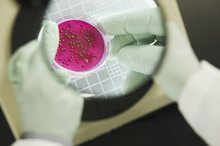List of Common Pathogenic Bacteria That Affect the Human Body System
Bacteria are all around us, in the air, on objects and normally found in and on the human body. When bacteria is on the human body in the absence of disease, it is called a colonizer. However, people can get infected from pathogenic bacteria from food, water, abrasions and other wounds and even from colonizing bacteria if it gets into a normally sterile part of the body. A pathogenic bacteria is one that causes disease in the host. The list of pathogenic bacteria is quite large, but there are some that are common causes of disease in humans.
If you are experiencing serious medical symptoms, seek emergency treatment immediately.
Staphylococcus
The group of bacteria known as staphylococcus, particularly Staphylococcus aureus, are one of the most common causes of human disease. Most staphylococci colonize the skin and mucous membranes of people without disease. However, given the right conditions, staphylococci can cause superficial and systemic infections. Some of the more common superficial infections caused by S. aureus include boils, impetigo and folliculitis. More serious and common infections caused by this organism are pneumonia, bacteremia, and infections of the bone and wounds. Staphylococcus aureus can also produce toxins that can cause such diverse diseases as food poisoning and toxic shock syndrome.
Other species of staphylococci that commonly cause disease in humans is Staphylococcus saprophyticus. This is a common cause of urinary tract infections in sexually active women.
- The group of bacteria known as staphylococcus, particularly Staphylococcus aureus, are one of the most common causes of human disease.
- More serious and common infections caused by this organism are pneumonia, bacteremia, and infections of the bone and wounds.
Streptococcus
5 Different Types of Bacteria
Learn More
Like staphylococci, there are many species of streptococci found normally in the human body. Certain strains of streptococci cause some of the most serious diseases in humans. Streptococcus pyogenes (strep group A) is the main cause of bacterial pharyngitis (strep throat) in people. Untreated strep throat can lead to serious sequelae like rheumatic fever (heart valves) and glomerulonephritis (kidneys). Other infections include impetigo and the devastating "flesh eating bacteria" otherwise known as necrotizing fasciitis. In necrotizing fasciitis, there is rapid destruction of the soft tissues and muscle. This is a frequently fatal disease and rapid treatment is necessary.
- Like staphylococci, there are many species of streptococci found normally in the human body.
- In necrotizing fasciitis, there is rapid destruction of the soft tissues and muscle.
The Gram-Negative Bacilli
There are dozens of different species of gram-negative bacilli, with many species normally found in the intestinal tract. In the intestinal tract they have a beneficial effect on the body by preventing overgrowth of potential pathogens. However, if by surgery or trauma these bacteria get out of the intestine, they can cause serious, life-threatening disease. One of the more common gram-negative bacilli that cause disease in humans is Escherichia coli. According to Bailey and Scott's "Diagnostic Microbiology," E. coli is by far the most common cause of uncomplicated community acquired urinary tract infections and is frequently seen in wound infections 2. Certain strains of E. coli (such as E. coli O157:H7) can cause serious diarrhea and kidney damage.
Salmonella and Shigella are two gram-negative bacilli well known for being causes of food poisoning and dysentery, respectively.
The gram-negative bacilli have been implicated in infections as diverse as pneumonia to ear infections.
- There are dozens of different species of gram-negative bacilli, with many species normally found in the intestinal tract.
- The gram-negative bacilli have been implicated in infections as diverse as pneumonia to ear infections.
Neisseria
List of Common Bacteria and Guardia Found in Creeks & Streams
Learn More
The majority of Neisseria species are found normally in the mouth and female genital tract. However, there are two species that can cause very serious disease in humans.
Neisseria gonorrhoeae is the cause of the sexually transmitted infection gonorrhea. This is a major public health issue in the United States and worldwide. Untreated infections of gonorrhea can lead to more serious disease like gonococcal arthritis and pelvic inflammatory disease (PID).
Neisseria meningitis is the causative agent of meningococcal meningitis, a serious, potentially life-threatening disease of the spinal fluid and meninges.
- The majority of Neisseria species are found normally in the mouth and female genital tract.
- Neisseria meningitis is the causative agent of meningococcal meningitis, a serious, potentially life-threatening disease of the spinal fluid and meninges.
Related Articles
References
- "Koneman's Color Atlas and Textbook of Diagnostic Microbiology;" Elmer Koneman, MD; 2006
- "Bailey and Scott's Diagnostic Microbiology;" Betty Forbes, PhD, 2002
Writer Bio
Robert Herriman has been writing for the the web site, examiner.com since 2009 as the Infectious Diseases Examiner. Herriman has experience in the fields of microbiology and infectious diseases since 1989. He has previously written for "Continuing Education Topics" publication for the American Medical Technologists. Herriman holds a Master of Public Health from the University of South Florida.









